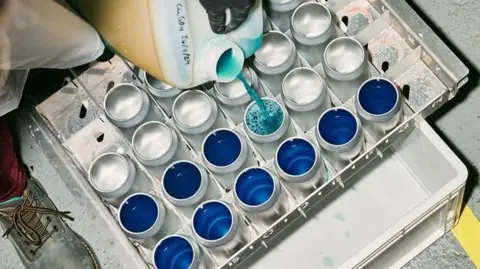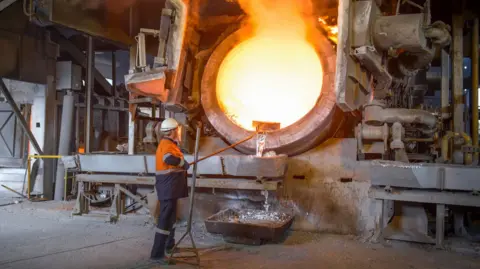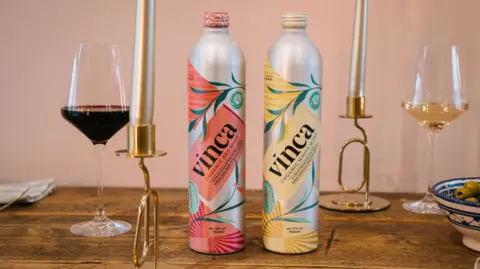Expertise Reporter
 Meadow
MeadowIn entrance of me is a line-up of aluminium cans, however not a drink in sight.
As an alternative, these cans have been designed to carry toiletries like shampoo, bathe gel and hand wash, condiments like ketchup and family cleansing merchandise.
I am on the London analysis and growth centre for Meadow, a start-up that has developed a brand new packaging system.
Their concept is to maneuver merchandise presently packaged in plastic to aluminium cans.
The founders consider it might be the following large step in lowering the quantity of plastic packaging on the planet, because of the excessive recycling rate of aluminium cans compared to plastic – 81% vs 52%, based on figures from the Nationwide Packaging Waste Database.
Meadow has taken the everyday aluminium drink can and tweaked it, so that it’s going to slot right into a cannister, which could be outfitted with all types of dishing out choices.
So relying on the contents, you may have a pump, a squeeze prime, spray nozzle, screw prime lid or different choices.
The can itself has a sealed prime and crinkles on the edges to make it clear the contents aren’t to be drunk.
When the can is empty, it may be taken out for recycling, and changed with a brand new one.
Aluminium can producer Ball, which already affords recyclable aluminium packaging for shampoos and lotions, has invested in Meadow and can provide the system to the massive private care manufacturers it really works with.
“We realised the greenest container already exists – the aluminium can. So we thought, what do we have to do, to take it to new industries?” says Victor Ljungberg, Meadow’s co-founder and chief government, who relies in Stockholm, Sweden.
 Meadow
MeadowAluminium has sturdy recyclability credentials; it’s thought-about to be infinitely recyclable, in contrast with plastic, which loses its high quality after being recycled a number of occasions.
Additionally it is lighter than glass, so the power wanted to move aluminium cans is considerably lower than glass bottles.
The wine business has already trialled full dimension aluminium bottles, with natural model Vinca rolling them out in March by means of Tesco. Aldi this 12 months additionally launched an own-label wine in an aluminium bottle.
Extra industries are set to make the leap, as new EU packaging and waste regulations come into impact in January 2030, stating that every one packaging must be at the very least 70% recyclable. By 2038, the minimal degree of recyclability for packaging will leap to 80%.
 Getty Photos
Getty PhotosSo what would possibly maintain again aluminium?
Producing new aluminium is power intensive. It requires virtually twice as a lot power to supply than glass.
Calculating the environmental impression of aluminium versus glass is complicated and sometimes your best option will depend on what’s being shipped.
Value is certainly an element, based on Mark Lansley, the proprietor and chief government of Broadland Drinks, which provided the aluminium-bottled wine to Aldi, and has one other comparable launch deliberate this 12 months.
Aluminium, explains Mr Lansley, is a 3rd lighter than glass, saving about 900 grams of CO2 emissions – however is 4 occasions costlier.
He admits to absorbing the additional value alongside Aldi within the title of innovation, however says that aluminium turning into extra extensively adopted depends on its value coming down.
“We have got to recover from this value. We have got to promote the advantages and higher spell out the decrease carbon footprint that aluminium has,” says Mr Lansley.
Shoppers may even must adapt to completely different trying packaging.
Mr Lansley says the wine business already tackled this problem when it launched screw tops, however in terms of packaging, there are just a few conditions the place solely a glass wine bottle will do.
“Aluminium bottles are lighter and do not shatter, so they’re much higher for a picnic, or by the pool. However then you definitely’ve bought custom, and what people are used to.
“You is perhaps opening a bottle of wine to have a good time with associates, or as a reward and leisure. A glass bottle of wine is embedded in that tradition,” says Mr Lansley.
 Vinca
VincaA variety of what shoppers affiliate with their favorite manufacturers has been deliberately pushed by these manufacturers, and altering that might take a variety of convincing too, notes Jamie Stone, packaging professional at world innovation consultancy PA Consulting.
“Large manufacturers have spent many years and invested billions in educating clients on distinctive packaging – consider the long-lasting Heinz ketchup bottle, a bottle of Flash spray, or Kikkoman soy sauce,” Mr Stone, who’s London-based, factors out.
“Aluminium cannot simply make formed packs. That is a problem when form kinds a key a part of model identification and shopper recognition. Assume what number of on a regular basis merchandise – like sauces, shampoo, washing up liquid, or moisturisers – depend on squeezable packaging. Aluminium, being inflexible, removes that performance.”
He provides: “In lots of classes, shoppers need to see the product they’re shopping for, whether or not it is the color of a juice, the consistency of a lotion, or the thickness of a sauce. Aluminium’s opacity removes that visible connection.”
Mark Armstrong is a design director at inventive company Marks, which has designed packaging for Starbucks. He says one purpose we’ve not seen aluminium packaging turn into the norm, is that producers have long-established plastic packaging strains.
These would require important modification or substitute to deal with aluminium, at a excessive value. And, most food-grade aluminium wants inner lacquer or polymer coatings, which should additionally meet recyclability tips, Mr Armstrong provides.
“Aluminium is arguably the champion of recyclable supplies. However the choices for dishing out and reseal-ability typically depend on a secondary plastic materials. This then compromises the recyclability for shoppers if it requires them to separate out supplies to be recycled, which enormously weakens the enchantment,” says Mr Armstrong.
Improvements in plastic’s sustainability additionally cannot be ignored, from the event of ones that may be infinitely recycled, to those who are biodegradable.
For that purpose, Jayne Paramor, sustainable packaging lead at sustainability consultancy Anthesis, argues that plastic should still find yourself as manufacturers’ packaging of selection.
“Plastics stay extremely suited to many packaging purposes on account of their sturdiness, inertness and design flexibility,” says Ms Paramor.


